Discover what goes on inside the Global Neighborhood, Elon’s newest residential neighborhood that blends academic and residence life to create a vibrant, 24/7 learning environment.
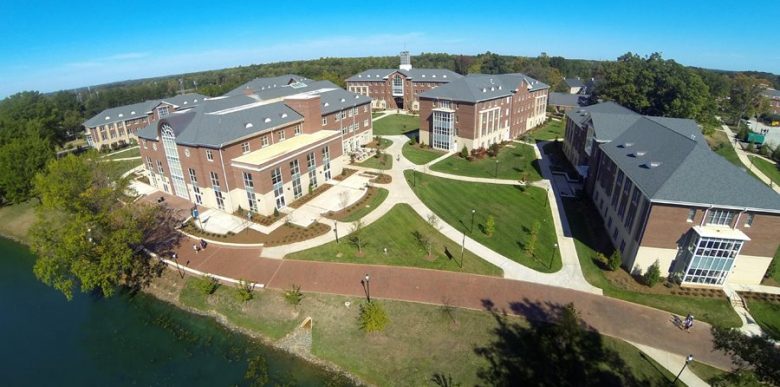 This story originally appeared in the Fall 2014 edition of The Magazine of Elon.
This story originally appeared in the Fall 2014 edition of The Magazine of Elon.
Classrooms. Study areas. Offices. Bedrooms.
Walk into any of the six buildings in the new Global Neighborhood, which was completed in fall 2014, and you will find a mixture of these spaces. It’s not uncommon for students to attend classes in the same building where they live, or to have discussions with professors over coffee at the Global Commons or to stop by one of the living spaces for faculty and visiting international scholars found in the neighborhood. After hours, classrooms become lounges and office areas that otherwise would be empty become gathering and study spots.
This seamless integration of classrooms and residential spaces did not happen by accident. As part of Elon’s Residential Campus Initiative, the neighborhood was designed with this purpose in mind. “We want students to think about the learning that occurs all the time, not just in class,” says Jon Dooley, assistant vice president for student life and dean of campus life. “The concept is to expand from classrooms of learning to a campus of learning. Our students and alumni speak highly about the impact of their relationships with faculty members—interactions that often happened outside the classroom, such as through advising or research with a faculty mentor. We are trying to increase the likelihood of that mentoring and those relationships.”
The neighborhood is more than a beautiful space, though its architecture has transformed the area surrounding Lake Mary Nell. It houses almost 600 students, of which 71 percent are first-year students, in five residence halls or “houses”—think Harry Potter. It also features a 50,000-square-foot commons building housing the Isabella Cannon Global Education Center, academic offices for the Elon Core Curriculum and Project Pericles, multimedia rooms, a digital theater, Argo Tea (an organic tea café) and the Great Hall, a three-story studying and gathering space with large windows overlooking the lake. All these features, Dooley says, facilitate the out-of-classroom interactions that lead to a richer experience for students.
 8:25 a.m. | Breakfast and Conversation
8:25 a.m. | Breakfast and Conversation
It’s time for breakfast, and Leena Dahal heads to the faculty apartment on the first floor of Global Building C, where religious studies professors and husband-and-wife team Brian Pennington and Amy Allocco live. As she sits at the table enjoying a traditional home-cooked Indian breakfast, Dahal discusses undergraduate research opportunities with Pennington. A year ago, the sophomore from Nepal and Malaysia would not have been comfortable having that conversation. “I was extremely terrified when I first came to Elon,” she says, “not only because it was my first time in the United States but also because I’m generally a shy person.”
Being part of the International Living Learning Community, one of several such communities housed in the neighborhood, has allowed her to have the confidence to speak up. She was able to take a “linked” class with members from her house during her first semester, something that led to interesting conversations. “Just the other night,” she says, “I walked into my hall and found my fellow residents discussing the different cultural interpretations of human evolution … in our pajamas … on a Tuesday night.”
These kinds of interactions have come to define Dahal’s college experience. She is now comfortable approaching Pennington and having intellectual conversations in a class, at a dinner or after watching a film. “When I came here for the first time, I thought the community would consist of ‘likeminded people’ who I could identify with,” she says. “I was so wrong. The variety of viewpoints and perspectives you encounter here is what makes this community so exciting and I’m so glad I was proved wrong. I found a home in this neighborhood and a family in the people who comprise it; being a member has completely shaped my overall approach to college.”
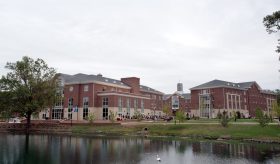 10:05 a.m. | Coffee break
10:05 a.m. | Coffee break
Students, faculty and staff from across campus gathered outside the Global Neighborhood during a recent College Coffee. Besides sampling teas from around the world courtesy of Argo Tea, they were encouraged to explore the Global Commons Building, including the Great Hall and many of the academic offices housed there.
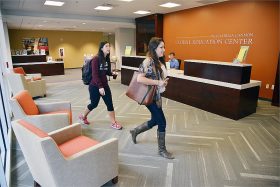 11:40 a.m. | New opportunities
11:40 a.m. | New opportunities
While students come and go on the second floor of the Global Commons Building, the folks at the Isabella Cannon Global Education Center are crafting new opportunities to engage students. All of the GEC’s programs, abroad and domestic, foster intercultural engagement, Woody Pelton, dean of global studies, says. But being in a busy building in the middle of a residential neighborhood gives the staff more opportunities for casual and spontaneous interactions with students. Last fall, for instance, the center hosted one of the neighborhood’s house dinners, leading a dynamic conversation on what it means to be global. Mark Dalhouse, director of Study USA, will lead another house dinner this year centered on the anniversary of the Voting Rights Act. The center also regularly hosts student, faculty and staff meetings and events in its space, such as the weekly meetings of the Elon African Society. “It’s an opportunity for the GEC to engage in the intellectual life of the university beyond our primary roles,” Rhonda Waller, director of study abroad, says.
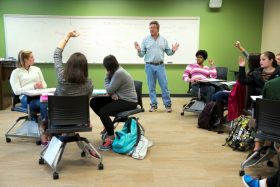 1:15 p.m. | Inside a classroom
1:15 p.m. | Inside a classroom
Professor of English Stephen Braye leads a class discussion on the first floor of Global Building B. As part of the Honors Global Experience class, students form groups to discuss the criteria they use when making decisions and how their actions affect those around them. “How we see other people determines how we live our lives,” Braye said during the discussion, adding we are constantly weighing different factors when making decisions: Are all people equal? Do we have a responsibility toward others? “The important thing is for you to understand your criteria so you can make purposeful decisions, not mindless decisions,” Braye said.
 4:10 p.m. | Linguistic encounters
4:10 p.m. | Linguistic encounters
The aroma of Illy-brand espresso from Argo Tea infuses the air in the Global Commons as Assistant Professor Brandon Essary and Adjunct Instructor Matthew Liberti lead an informal conversation in Italian as part of La Casa Italiana, a living-learning community housed in the neighborhood.
Students take turns introducing themselves and sharing details about their interests—Middle East studies, international relations, biochemistry, film. The conversation allows students to practice the language while speaking about Italian culture in a place that was designed to promote linguistic encounters. “In our increasingly interconnected world, it’s great to engage in Italian activities with other members of the Casa Italiana while also being in contact with students from other living-learning communities,” Liberti says. While the conversations are informal, they can have lasting effects. “You see students venturing up to the Global Education Center to get information on studying in Italy,” Essary says. “You take a sip of your macchiato, close your eyes, hear lively Italian conversation, and imagine for a moment you’re back in Italy.”
 5:45 p.m. | Dining with a purpose
5:45 p.m. | Dining with a purpose
More than 150 Global Neighborhood residents, along with faculty and staff members, gather to discuss the influence of children’s television programming on girls worldwide. The discussion was the second of six house dinners planned for the year, which bring students, faculty and staff together for intellectual discussions around a globally themed meal. This year’s theme is Gender and Sexuality Across Cultures.
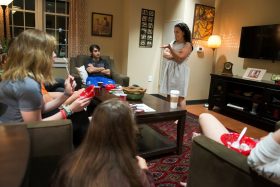 7:40 p.m. | Sundaes on Sundays
7:40 p.m. | Sundaes on Sundays
While most people spend Sunday relaxing at home getting ready for the week ahead, Assistant Professor Amy Allocco is entertaining students who, like her, live in the Global Neighborhood. As they enjoy ice cream sundaes, she tells them about her journey—how a trip to southern India during her undergraduate years transitioned into studying and conducting fieldwork there for 20 years and her passion for studying contemporary Hindu ritual traditions. She tells them about the many programs available in the neighborhood—film series, dinners, service opportunities through a partnership with the North Carolina African Services Coalition—and the transformative power of study abroad. She also encourages them to seek a mentor and a research area in addition to their class work.
Allocco, the university’s distinguished emerging scholar of religious studies, is the neighborhood’s faculty director. She moved there last fall after previously living with students in the Isabella Cannon International Pavilion for three years. She works in partnership with Rei Haycraft, assistant director of residence life, to develop academic programming. “I make a lot of connections,” she says of her role in the neighborhood. She often takes note of a student’s strengths or interests so that she can follow up with a referral or suggestion. She thinks about ways to foster global engagement outside the classroom and how to better encourage students to free themselves to dabble and explore all a liberal arts education offers. “There are these moments of exchange and reciprocity. They learn I wasn’t born to earn a Ph.D.,” she says. “I want students to think about unexpected detours as opportunities rather than mistakes.”
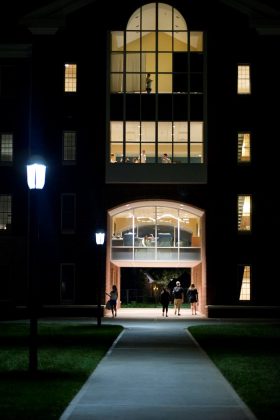 8:30 p.m. | Winding down
8:30 p.m. | Winding down
As night falls on the neighborhood, students take advantage of nearby amenities and the common spaces found in all five residential buildings. Many students have dinner next door at Lakeside Dining Hall or prepare their own in the spacious kitchens available on every floor. They can walk to the soccer field across the street or watch a football game in their hall TV rooms. Many students will likely stay up well past midnight completing assignments for the following day.


